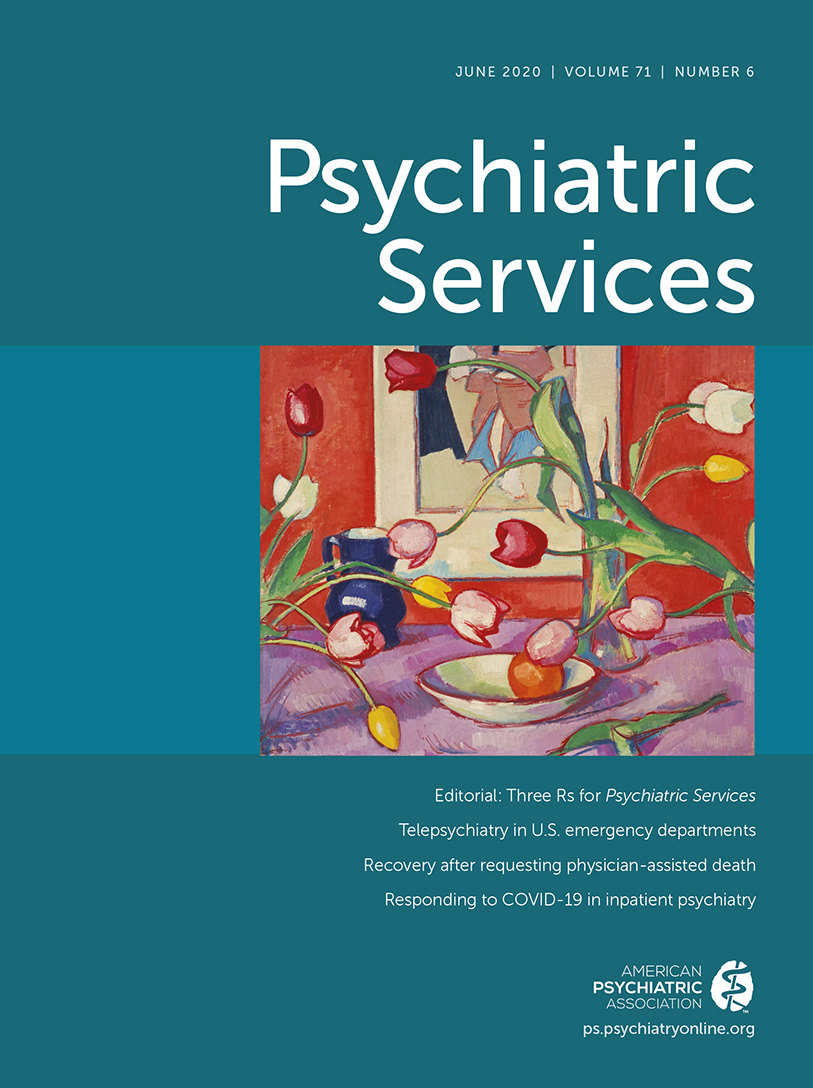This is the April 2020 Editor’s Choice collection. To review all collections, visit the Editor’s Choice section of
ps.psychiatryonline.org.
Telepsychiatry, or the use of technology to provide mental health services, has increasingly been studied to meet the growing demand for psychiatric care. Moreover, telepsychiatry has been implemented in various settings to address barriers to accessing psychiatric care, including shortages in mental health clinicians, remote geographic locations, social stigma related to initiating care in a mental health setting, limited mental health parity, and fragmented systems of care. The utility of telepsychiatry is relevant now more than ever, as the world endures a global pandemic and as mental health professionals seek ways to initiate and continue much-needed mental health services. For instance, where physical distancing (people keeping at least 6 feet apart) is necessary to prevent the spread of COVID-19, telepsychiatry helps meet the demand for mental health services. This benefit is of particular salience during the COVID-19 pandemic, as many clinics pare down their onsite mental health workforce to enhance safety of staff and patients.
This collection highlights the breadth of available telepsychiatry services, considerations for implementing telepsychiatry in various mental health settings, and billing implications. It also underscores the importance of helping patients use telepsychiatry services, understanding the toll this new platform can have on mental health providers, and offering ways to minimize burnout among telepsychiatry providers to improve outcomes for providers and patients alike. A host of telepsychiatry options are available, including services for patients with psychotic disorders, for veterans through the Veterans Health Administration system, and for people who live in rural areas. As we move through this crisis, we should do our best to implement needed telehealth interventions, maintain these services into the future, and expand the evidence base around telepsychiatry, including evaluating its impact on mental health services and patient outcomes.
Types of telepsychiatric services
E–Mental Health: A Rapid Review of the Literature
Lal S, Adair CE
Psychiatr Serv 2014; 65:24–32
E–Mental Health Self-Management for Psychotic Disorders: State of the Art and Future Perspectives
van der Krieke L, Wunderink L, Emerencia AC, et al.
Psychiatr Serv 2014; 65:33–49
Using Telehealth to Implement Cognitive-Behavioral Therapy
Dent L, Peters A, Kerr PL, et al.
Psychiatr Serv 2018; 69:370–373
The Use of Telepsychiatry to Provide Cost-Efficient Care During Pediatric Mental Health Emergencies
Thomas JF, Novins DK, Hosokawa PW, et al.
Psychiatr Serv 2017; 69:161–168
An Experimental Comparison of Telepsychiatry and Conventional Psychiatry for Parolees
Farabee D, Calhoun S, Veliz R
Psychiatr Serv 2016; 67:562–565
Design and implementation of telepsychiatry
Telepsychiatry Use in U.S. Mental Health Facilities, 2010–2017
Spivak S, Spivak A, Cullen B, et al.
Psychiatr Serv 2020; 71:121–127
Evaluating the Implementation of Home-Based Videoconferencing for Providing Mental Health Services
Interian A, King AR, St. Hill LM, et al.
Psychiatr Serv 2018; 69:69–75
A Description of Telemental Health Services Provided by the Veterans Health Administration in 2006–2010
Deen TL, Ph.D., Godleski L, Fortney JC
Psychiatr Serv 2012; 63:1131–1133
Increasing Mental Health Care Access, Continuity, and Efficiency for Veterans Through Telehealth With Video Tablets
Jacobs JC, Blonigen DM, Kimerling R, et al.
Psychiatr Serv 2019; 70:976–982
An Innovative Approach to Care: Integrating Mental Health Services Through Telemedicine in Rural School-Based Health Centers
Pradhan T, Six-Workman EA, Law K-B, et al.
Psychiatr Serv 2019; 70:239–242
Use of Tele–Mental Health in Conjunction With In-Person Care: A Qualitative Exploration of Implementation Models
Uscher-Pines L, Raja P, Qureshi N, et al.
Psychiatr Serv 71:419–426
Using Continuous Quality Improvement to Design and Implement a Telepsychiatry Program in Rural Illinois
Mahmoud H, Vogt EL, Dahdouh R, et al.
Psychiatric Services in Advance (online April 15, 2020)
Designing an Academic-Community Telepsychiatry Partnership to Provide Inpatient and Outpatient Services in a Critical Access Hospital
Kimmel RJ, Iles-Shih MD, Ratzliff A, et al.
Psychiatr Serv 2019; 70:744–746
Rural-Nonrural Differences in Telemedicine Use for Mental and Substance Use Disorders Among Medicaid Beneficiaries
Creedon TB, Schrader KE, O'Brien PL, et al.
Psychiatric Services in Advance (online April 15, 2020)
Billing and utilization
Assessing Telemedicine Utilization by Using Medicaid Claims Data
Daugherty Douglas M, Xu J, Heggs A, et al.
Psychiatr Serv 2017; 68:173–178
Telehealth Delivery of Mental Health Services: An Analysis of Private Insurance Claims Data in the United States
Wilson FA, Ph.D., Rampa S, Trout KE, et al.
Psychiatr Serv 2017; 68:1303–1306
Special considerations for telepsychiatry
When Will Telepsychiatry Reach Its “Tipping Point”?
Flaum MA
Psychiatr Serv 2017; 68:1205–1205
Telepsychiatry: Implications for Psychiatrist Burnout and Well-Being
Vogt EL, Mahmoud H, Elhaj O
Psychiatr Serv 2019; 70:422–424
Telemedicine for Mental Health in the United States: Making Progress, Still a Long Way to Go
Barnett ML, Huskamp HA
Psychiatr Serv 2020; 71:197–198

